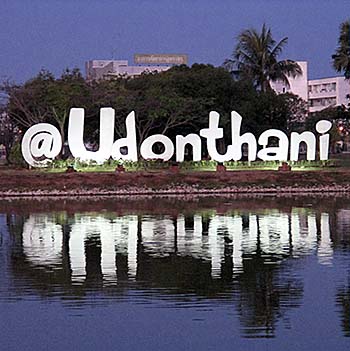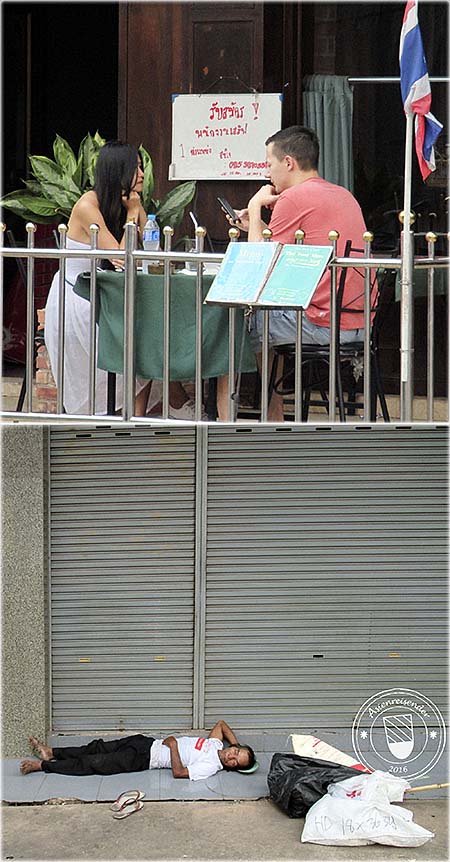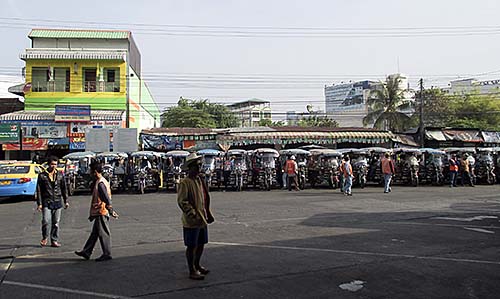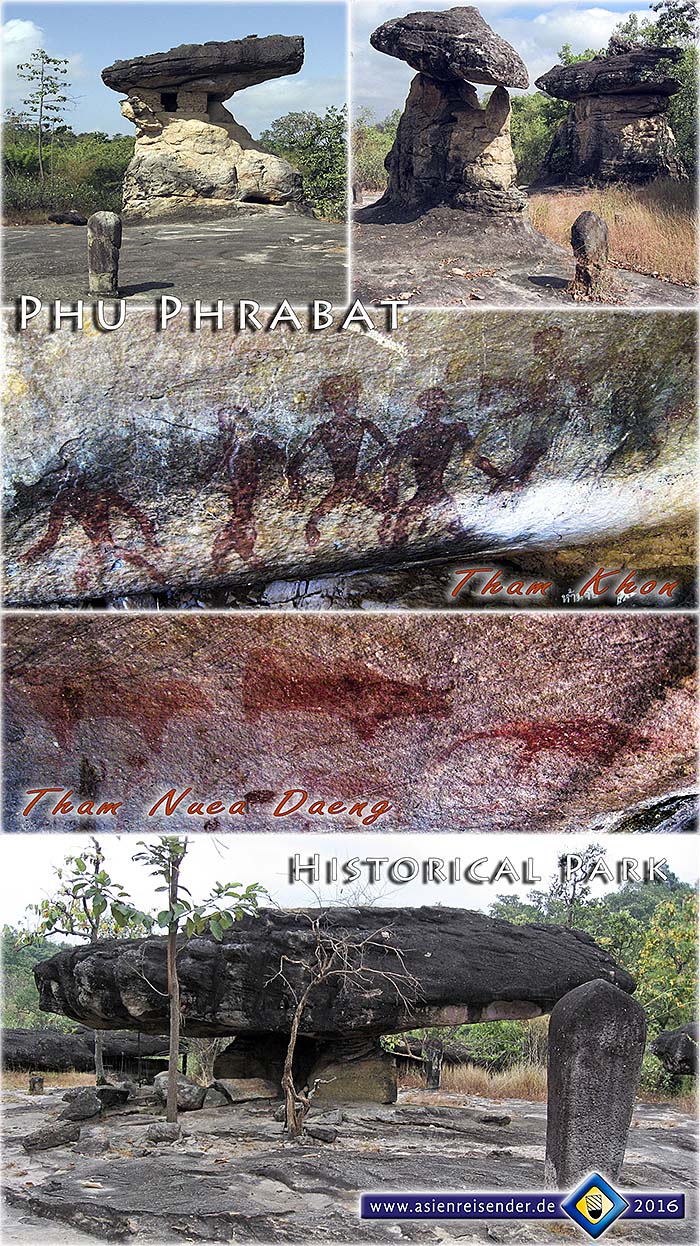1.
Udon Thani
Udon Thani is a city and province capital of the same name in Isan, Thailand's northeast. It's situated on the northwestern plains of the Khorat Plateau. The city is a traffic hub and trade center for the wider region. By the locals the place is usually called just Udon.
Nong Prajak Park

The parks are the great plus in Thailand's ugly and dirty concrete deserts. From the first sunlight on people come here to start the day with exercises. Image by Asienreisender, 1/2016
Udon Thani is among the four biggest cities in Isan. It's remarkable that all of these four, as Nakhon Ratchasima (Khorat), Khon Kaen, Ubon Ratchathani and Udon are connected to Bangkok with the northeastern railway line. The train connection triggered a growth boom from the early 20th century on. The railway continues north to Nong Khai at the Mekong River and is, since a few years now, also leading over the Mekong to Vientiane in Laos. It's planned for the soon future to expand and continue this railway line through north Laos deep into China. Thailand and Laos are knitting closer tights to each other (see also: 'A Bridge over the Mekong River').
Outside of the city lies a civil airport, while the formerly American war airport is used now by the Thai airforce since 1976.
Decadence and Poverty

Prostitution is what coins Udon Thani downtown mostly. Everywhere are girl bars and massage parlours where sirens sing their songs: 'Hello, welcome, want this, want that?!' Capitalism is a necrophile socialeconomic system in which anything is reduced to be a commodity - also people.
These Orientals, in their excessive consumerism and stupidity, are an alternative to western women because they are (relatively) cheap (in short term), look usually ten years younger than they are and one can get immediately rid of them when once being fed up with them. Once being married, they grow fat and ugly and get dominant. Western women therefore, in little contrast, are just another pain in the neck. All real and honest human relations are since a long time destroyed in the anti-civilization of money.
In stark contrast to the decadence of buying or hiring a girl friend stands the poverty in the same streets. Many people sleep on the sidewalks. Images and photocomposition by Asienreisender, 1/2016
The center or downtown of Udon Thani is around the main road which leads from the railway station westwards, together with some parallel roads. On arrival one gets no good impression: it's loud, dirty and coined by bars and guesthouses who appeal to the western taste. The bars are filled with old, fat and dull Westerners who spend their old-age pensions here together with changing young Isan girls. I wonder what they do here, for there are no other attractions in town; they would actually belong to Phuket or Pattaya; however, it's certainly the cheaper place here and that's one reason why. Another reason is the heritage of the American Vietnam War. Since the place was an important American air base, many GI's kept staying here after the war. The US engagement left a large redlight quarter with the for soldiers so attractive prostitution, drug abuse and criminality, to name just a few of the attributes of the American way of life.
The accomodation here is mostly in the middle range and only very few budget hotels or guesthouses are in the center. Tourism drives the prices.
The city is also plastered with Tesco Lotus branches, Big C malls and a number of other big shopping malls and large cinemas.
In the evenings the roads and sidewalks are crammed with foodstalls and shops who sell the most different kinds of things. Much of it is useless crap nobody needs. A waste of natural resources, a boost of pollution and resulting in enhancing the mountains of litter we see all around. But it brings some jobs and profit, and that's what it is all about, right?!
In contrast to the overindulging, alcoholic Westerners stands the apparent poverty in the city. I don't remember another Thai city with so many homeless people who sleep on the streets or in the parks. Udon Thani is also a center of the poor.
An Armada of Tuk-Tuks

Tuk-tuks at the bus station. Allegedly, Thailand has not more of an unemployment rate than about 1.2%. However, I would never trust any statistic, particularly not in Southeast Asia. Many men become drivers, what is a completely unqualified job. Many girls help in their family businesses, what is often a simple restaurant in front of the house or a stall on the market. They all are officially not unemployed. The same is with all the prostitutes in the tourist areas. If a Thai looses his job, he certainly doesn't tell the authorities, because it has no benefit for him. Who, then, is officially counted as unemployed?
By the way, there is a tuk-tuk factory in Udon Thani which supplies great parts of Thailand and nearby Laos with the vehicles. A tuk-tuk is not cheap; once a driver in Chiang Khong told me that he had paid a large sum for his one.
Image by Asienreisender, 1/2016
Since it's such an ugly place, I was tempted after arrival to directly turn on my heels and leave it. However, after checking in for one night I walked the streets and found soon a good area. It's always a great benefit of Thai cities that they all have large parks with greater lakes in them. One can walk in the green, avoiding the heavy traffic, and the air which comes from the water provides always a fresh breeze. Closely east of the railway station is one of these parks, called Nong Bua, where Thai (and some few Westerners) go for recreation, jogging or other exercises. There are also some sports facilites one can train his skills and muscles. One of the larger and colourful Chinese temples lies at the western shore.
Another park is a kilometer or so west of the railway station, following mostly the main road. Nong Prajack Park is larger than Nong Bua. It fills at the first daylight with people who also do sports here, many cyclists among them. The bigger lake has a spaceous peninsula.
In the province have large potash deposits been found. Potash is a mineral used for fertilizers. The exploitation of the resource would mean a great export business. However, there is resistance in the local population, for the villages in the region base on an income made by farming, while the potash mines would supposedly salinize the ground waters and insofar destroy the very economic base of these local communities.
Another observation was the abandunce of sugar cane fields in the province. Along highway 22 is also a big, dirty factory with chimneys who produce a lot of dark smoke. Since on the other side nearby is a large parking for trucks loaded with sugar cane, I guess it's a sugar factory. Might be they burn alcohol out of the crop here.
It should be added that there is a lake called Nong Han in the province, which is not to confuse with the much larger Nong Han Lake of Sakon Nakhon.
2.
The History of Udon Thani
About 50km east of the city, still in Udon Thani Province, lies Ban Chiang. In Ban Chiang is the most important pre-historial site in Southeast Asia located. Ban Chiang is the first place in the world region where people became sedentary and developed rice cultivation, animal domestification and performed the transition from the neolithic age to bronze age and later iron age.
Some 60km northwest of Udon Thani is Phu Phrabat Historical Park situated. On a mountain ridge are several bizarre sandstone formations who remind to those in the Phu Phan Mountains at Mukdahan. These rocks have been originally shaped by erosions in the last ice-age. Here (as in the mountains around Mukdahan) are some pre-historical rock paintings to see.
Phu Phrabat Historical Park

At the western edge of the Khorat Plateau, mountains rise out of the high plains. It's the Phu Phrabat Buabok Mountains. They are not very high, about 120m to 160m above the surrounding plains level (320m to 360m avove sea level), and their slopes are rising softly. Only to the north are some steep cliffs, from which top one has a good view over the Mekong River valley and sometimes, when the air is clear, into Laos.
The mountains here are the source of several rivers who flow towards the Mekong, and the vegetation is completely different to that in the plains.
Many of these remarkable sandstone formations who give partially shelter to the sun and rain are here; some of them have ancient rock paintings preserved over thousands of years. As always, the dating is arguable; it's estimated that they are of an age of at least 3,000 years old. The oldest estimations date them back to 8,000 years. That is a bit older than the settlement of Ban Chiang is dated. The people who lived here and used the rock formations as a shelter were still not sedentary as those in Ban Chiang.
There are altogether 68 pre-historical structures, 23 sandstone tablets and 45 rock paintings in the park. The most prominent of them are those in the 'cave of men' (tham khon) and the cave of the red oxes (tham nuea daeng). A part of the rock paintings have been widely faded out over the time, particularly those who are more exposed to the sun.
In the middle ages people from the Dvaravati Culture (see also: Lopburi) added Buddha reliefs and these stone tablets who are placed in circles around some of the rocks. From the 9th century on there is an Angkorean influence supposed.
Archaeological research started in 1972. The park was officially registered in 1981, opened for the public in 1989. Since 2004 it is nominated as a UNESCO World Heritage.
Images and photocomposition by Asienreisender, 2006, 2016
In the middle ages the territory of Udon Thani was first part of the Dvaravati Culture, later part of the empire of Angkor. In the long Thai - Khmer wars the region came for a while under the rule of Sukothai. Also Lan Xang, one of the three Laotian kingdoms of the time, took power over the region. In later centuries it came also under control of a Burmese kingdom. It was in the time of king Taksin's conquests when it came to Siam in 1772.
The population here took part in the 1826-28 uprising led by the Laotion king Anuwong, who wanted to free the vassal kingdom of Vientiane from Siamese rule. This Laotian army was beaten in a battle at Nakhon Ratchasima (Khorat) in 1827.
Udon Thani City is a new place with little history. It was founded in the late 19th century by prince Prajak Sillapakhom, one of the son's of king Mongkut (Rama IV, reign from 1851 to 1868). The first name of the town was Ban Mak-kaeng then.
In the time of the First Indochina War about 47,000 Vietnamese war refuges came to Udon Thani. The city is still home for the largest Vietnamese community in Thailand. The stream of immigrants to the place is still going on, now for economic reasons. Much of the immigration is so called 'illegal', and the people on the search for a job now do not come only from Vietnam, but also from Indonesia, Laos, Burma/Myanmar, China, the Philippines, Bangladesh, India, Pakistan...
Udon Thani is one of the places where the USA had one of their airbases from where they attacked the neighbouring countries Laos and Vietnam in the American Vietnam War (see also: 'Bombs on Laos'). The American investment triggered an economic boom and left a for the time advanced roadnet.